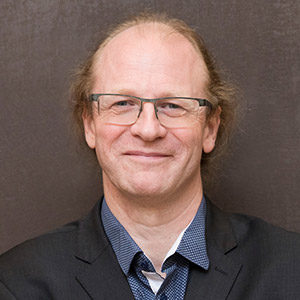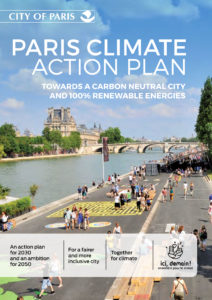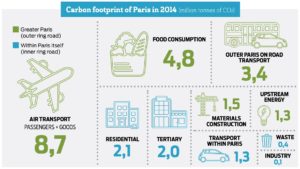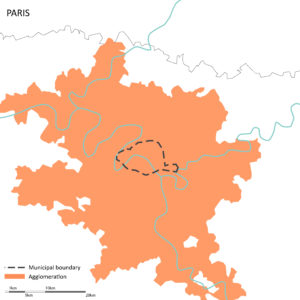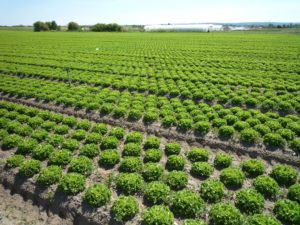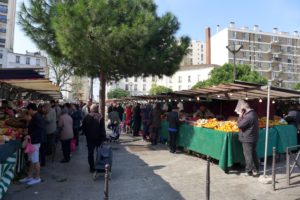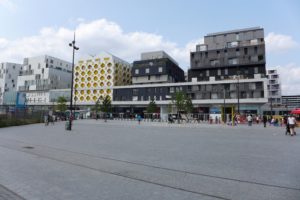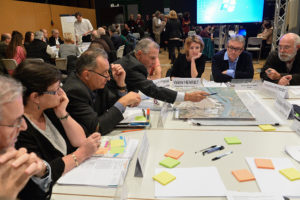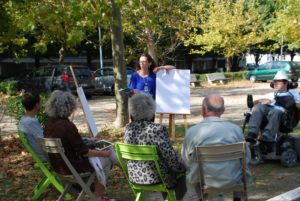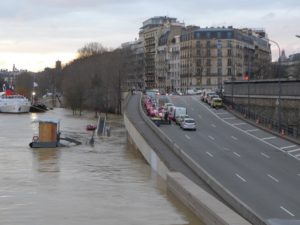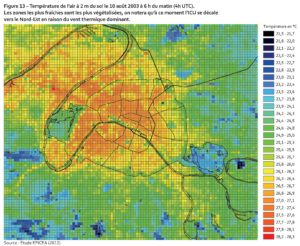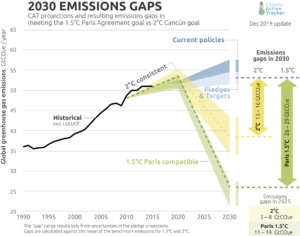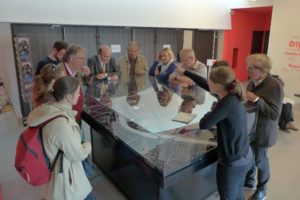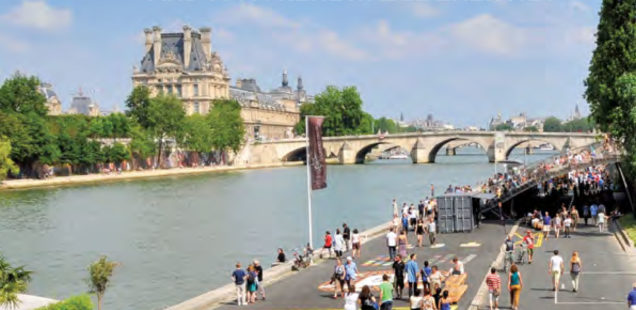
Climate action plans, interview with Yann Françoise
Mr. Yann Françoise is responsible for the energy strategy, the fight against climate change and the circular economy of the City of Paris. An engineer in urban engineering by training, he has become over time a specialist in energy issues and the fight against climate change in major cities. Since the launch of the City of Paris Climate Energy Plan in 2005, he has been involved in its implementation and development with the objective of carbon neutrality in 2050.
Interview by Christian Horn, Kateryna Sykina and Essia Turki on February 5, 2020 at the Paris city hall.
C.H.: Mr. Yann Françoise, the current climate action plan of the City of Paris was adopted in 2018. It is part of a succession and evolution of the climate plans, since the decision in 2005 to draw up a first Territorial Climate Energy Plan (PCET) of the City of Paris. How would you situate the climate action plan? Is it a new planning tool, such as the mobility plans developed by cities since the 1990s, or does it represent a more general orientation which serves as a guide for most aspects of the governance of a city?
Y.F.: The climate plan can be seen today as a planning tool in France. It became a legal obligation by a national law in 2010. Later this law was reinforced in 2012 and in 2015. So as it is a legal obligation now, we can consider that it is a planning tool. But for certain French cities, including Paris, it is not only seen as a planning tool. For us, it is rather a tool of dynamics, strategy and vision.
The first Paris Climate Plan dates from 2007, as well as those from four or five other cities in France, which were pioneers in the ambition to fight climate change at that time. In these cities, between 2005 and 2008, environmental policies emerged, either for sustainable energy or for climate issues in Europe. And when there is no guiding law yet, sometimes it’s better, because it allows you to be much more proactive and ambitious than simply responding to a text of a law. Besides at that time, there was a small competition between the forerunner cities, because London had just adopted its climate plan. This made it possible to go beyond the legal and administrative framework introduced by the law of 2010 and be more inventive. It’s only in its latest version of 2015, where the legislation encourages cities to think beyond its own administrative limits.
I will give you a very simple example. If we look at the balance of greenhouse gas (GHG) emissions that we calculated in our climate plan, we calculated a balance for the entire Greater Paris territory. But when we look only at the emissions from the administration of the city of Paris, this is what the law asked for at the start, it is much more limited.
The Paris administration is important. It is 55000 agents, 3500 public equipments, 1700 km of roads, 22 directions, but its activity represents only 1% of the Greater Paris territory’s emissions. Just 250000 tonnes out of total 22 million tonnes for the entire territory. So making a plan on 1% is not of much interest. This is how the dynamic is born. This is the reason I say that it is not a planning tool in the proper sense of the term. It is a tool that commits to a long-term vision of a 25% reduction in energy consumption and others. And engage sometimes on topics where the mayor has absolutely no competence.
K.S.: When we comparing the climate action plans of cities, for example Paris and Berlin, at first glance the main categories are similar or even identical: energy, mobility, buildings, town planning, waste, food … But in detail, every city is different. What are the specific points of the climate plan for the city of Paris compared to other European cities?
Y.F.: A special feature of the Paris Climate Plan is that, from the beginning we tried to take into account the consequences of our food and our consumptions on the Greater Paris territory, even if the emissions are not created within Paris itself. Of all the food consumed in Paris only 0.1% is produced in Paris. But it generates greenhouse gases outside the city’s administrative boundaries, and therefore we have a responsibility for these emissions.
We developed a sustainable food policy for Paris. We tested it in our own canteens for 15 years, to see if it worked or not. This exemplarity side is important. We test actions first “at home”, in the municipal public domain with our resources, we do the calculations and we see if we can export it to the municipal canteens.
In the first climate plan of 2007, we announced that we will be able to use up to 30% organic and local food in our Parisian canteens in 2014. The Parisian canteens, it’s 30 million meals a year. This seems a lot, but in fact there are 2 million meals a day that are served in Paris, for all Parisians, workers and tourists, a total of 730 million meals a year. At first, we were at 6% organic and local food and many people said that we could never reach 30%. There is no production chain, no logistics, and the agriculture federations would not support the engagement. But in 2013 we were already at 27%. In 2014, when the new mayor of Paris was elected, she announces in her campaign that we are going to 50% in 2020. And last year, in 2019, we were at 48% organic and local food in our Parisian canteens.
We have achieved our goal. By putting so many meals on the public market, the production chains developed, but not immediately. For example, at the very beginning, the organic carrot came from Sicily because we did not produce organic carrots in France. I lost in the calculations the gain in greenhouse gases with the transport from Sicily. So we created local production chains.
It’s the same message we try to convey here. If we develop our food strategy at the territorial level, we can develop organic farming in the Paris region. Because it is very rich land for agriculture. But which are dedicated to the monoculture of wheat, cereals for cattle and not at all to feed people. So we can restore agricultural value by investing these lands for organic and local food production.
So we decided to count in our climate clan the emissions that we generate elsewhere. Food is the second post. As the first post, there are planes for example. It is also the only climate plan that takes into account aircraft emissions in its balance sheet. And you should know that in the most recent balance we published, that the planes contribute 7.6 million tonnes out of the 22 million tonnes of CO2 of the city of Paris. It is a third of the emissions and on which we can do nothing.
E.T.: For you, are there issues and problems linked to climate change, which are still underestimated and insufficiently taken into consideration in the current climate plan?
Y.F.: We have a serious concern about the heat waves during the summer months and their impacts on the health of the citizens, especially vulnerable people. Our territories are not adapted to hot weather. From now on you have to get used to peaks of temperatures from 50 to 52°C in the streets. During the major heat wave in 2003, there were 15000 additional deaths due to high temperatures in France. Different measures were taken since then and last year, there were an additional 1500 deaths during the summer heat wave. So, one might think that the problem has been brought under control.
Except that in 2003 we had 17 hot days in a row. In 2019 we only had small heat waves of 4 to 5 days. Hard to bear, but without really getting tired. It is from 5 to 7 days in a row of heat waves that excess mortality in Paris is accelerating. And from the 9th day of exceeding 30°C, the risk of mortality for elderly doubles. Because you get tired, you dehydrate and you recover badly at night. The apartments are not suitable, they are often small and mono oriented. Even with the development of urban cool islands, the temperature does not drop enough overnight.
In my opinion we have lost 15 years since 2003, because we have not done enough research on summer overheating in housing and urban spaces. We put efforts to isolate housing for winter comfort, but we forget to explain to the elected officials that the renovation of housing is not only for winter, but also for summer comfort. In the context of global warming, it is also a question of temporality. In a few years we may be able to reduce the efforts for winter comfort, but it is clear that we will have to strengthen our efforts for summer comfort.
C.H.: The climate energy plan is rather a recent strategy and urban dynamic tool. It questions different themes and asks for a close collaboration between the departments and news way of collaborating. Were the different departments able to adapt quickly to the requirements of the climate plan?
Y.F.: The climate plan is also a new vision to think and share the city. We too, as administration, must make progress on this. In many cities, one has the impression that the administration manages the territory. It’s normal; we were given the keys to manage the territory. Now we have to learn how to share this management. Already to share governance a bit with, for example, the neighborhood councils that we have created.
I knew a time when, the administration decided on an designing an urban space and we carried it out without asking anybody questions. Today we go and talk to people first. They also vote on urban design proposals. They can disagree with the administration and we will respect them. Except when it’s really not possible otherwise. And this is new.
Sharing the governance also makes it possible to avoid these social acceptability difficulties at some point. Because citizens also understand our difficulties, whether technical, administrative, political, or purely financial. « Where do you want to put this tree ? Well below there is a gas network and an electricity network, so we can’t do it for security. » To say that everything is not doable.
During two climate plans, so for 10 years, we managed the climate plan with a classic steering committee made up of elected officials and the administration. We reported once a year to the wider community, presenting the figures published each year, without dialogue.
Since 2019, the City of Paris has an Climate Agora which will become a governance committee with a college of citizens, a college of NGOs, a college of NGOs and an administrative college. The administrative college is only there as an observer to be able to answer questions. The Climate Agora analyzes the progress we make each year, looks at the priorities we have indicated and makes proposals. Representatives of the Agora come to the steering committee to present the committee’s opinion to elected officials and the administration. We’ve been testing this agora twice in two years, so we still are in a continuous learning.
KS: The Russian national government ratified the Paris Agreement of 2015 in September 2019. If a city in Russia wants to engage now in the reduction of greenhouse gas emissions and in the ecological transition, where and how should they start? Knowing that on the one hand, it is a long-term process, but on the other hand, they must show some first results to the public in one or two years.
Y.F .: My role is, among other things, to develop monitoring strategies, to pilot and it’s also about measuring them. My initial job was to audit greenhouse gas emissions. I’ve been doing this for 25 years and fortunately, I don’t just do that. These audits of the emissions of a territory, it is nine months of data collection, work and analysis to check everything and we evaluate every five years.
In our current 2019 assessment, there was a non-negligible acceleration in emission reductions compared to the previous 5-year period. There is an underlying dynamic which began to emerge in 2009, a little more in 2014 and in 2019, is clearly visible. But when you are engaged in an important structural policy, the gains at the beginning are very, very small. They are thin and uncertain, but they grow over time, and over the years.
Now how do we commit to short-term actions? We have to launch the dynamic and show that it works, it reassures everyone. And above all, I think that in all communities, we have to reassure our financiers, that the money they invests, immediately creates returns. So you have to invest in things where you are sure to have very quick returns. There are lots of things where we can get very quick feedback, like communication and awareness raising. If we do it very well and repeatedly for a year, whether for the general public or in your teams or your companies, it will work and you will have 20% to 25% immediate gain. But if you don’t resume the exercise regularly, you lose the 20 to 25% of immediate gains again.
So both are essential means. You should launch structural policy before short-term actions, so that it shows the first results, when short-term actions have had their effects .
For all those who started early, like us in the city of Paris, we had time to start slowly. We now had 15 years, from 2005 to 2020, to try and move slowly. But now we are entering a critical period. We tell everyone that there is only 10 years left to act. For all the communities that are launching themselves today, they have 10 years left to go even faster than we did. So don’t miss it and put everything on the table now.
E.T.: If a city in Russia is searching to exchange experiences and knowledge on the issues of the ecological transition, are there associations, working groups that they can join? Can they contact the city of Paris for advice for example?
Y.F.: Each mayor can always get in touch with the city of Paris and it will go through diplomatic paths. But a city, a mayor, or a committed and voluntary technical service will also find links and contacts in major networks, such as ICLEI, C40 or Global Covenant of Mayors for Climate & Energy. Their goal is to assimilate information, knowledge and share it. We welcome cities to share knowledge and help those who are behind to increase their knowledge quickly. Between cities, there is no competition of knowledge or hiding information. There is competition with London, Berlin on, for example, the financial centre, but not on climate issues. I’ve been travelling around for 15 years to export our knowledge and learn from others. Here we are united to exchange everything we know and learn from each other. So what I’m saying, between cities the cooperation is ongoing.
It is important, however, to find a city that is roughly in the same configuration. When I first went to a city in China, I wanted immediately to leave; I was ashamed, because Paris is a district, a village compared to these cities. In Paris, we don’t have a hundred thousand people a year coming to the city and for whom we must urgently build. So, that’s important. If it is a city with an industrial port or others, you will contact Rotterdam as example.
There are networks that can help and it is easier to go through networks or friendship and cooperation agreements. These networks bring together elected officials with elected officials, technicians with technicians, so that they speak the same language and understand each other. I want to say that it shouldn’t be difficult to get the knowledge. You just have to throw the message in a bottle into the sea overboard and get started.
Author: Christian Horn is the head of the architecture and urban planning office RETHINK in Paris, France
The interview was conducted as part of the work of the climate group of the Parisian Council of Europeans
The article has been published in the magazine Project Baikal n°64
Sources
Ville de Paris. (2018). Plan Climat Énergie. Consulté à l’adresse https://www.paris.fr/pages/paris-pour-le-climat-2148/#le-plan-climat-energie-de-paris
